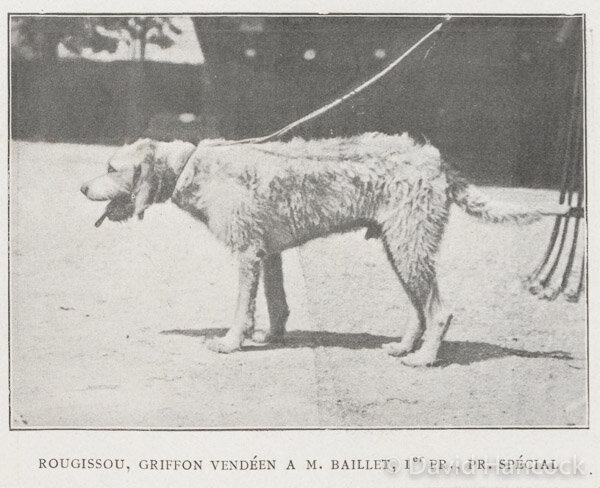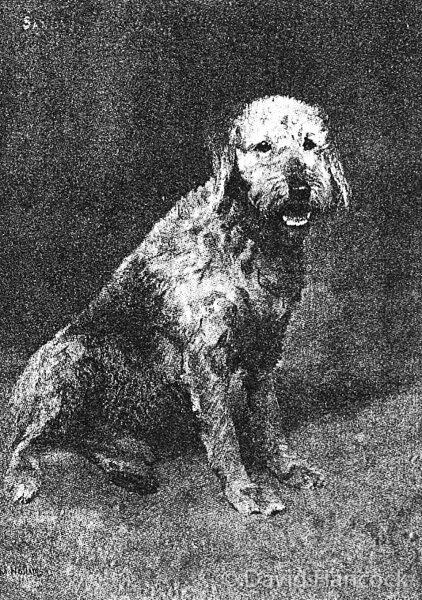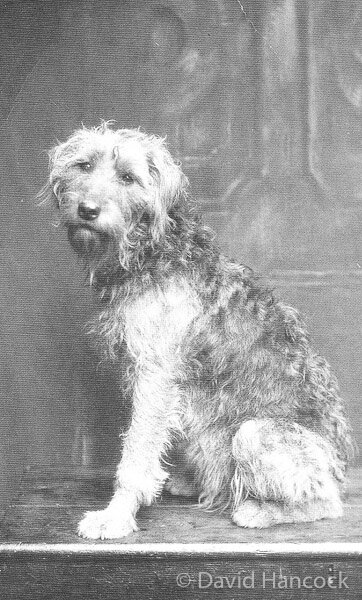1173
THE AIREDALE - HOUND OR TERRIER
By David Hancock
“The tractability of the Terrier and the Airedale in particular may be judged by an advertising catalogue published periodically by a large Airedale kennel during the 1920s. This catalogue offered Airedales trained to suit the purchaser. The list of pursuits for which they could be trained was as follows: police work, farm dogs, for sheep or cattle; hunting dogs for bear, wolf, fox, deer, wildcat, lynx, skunk, coon, opossum, etc.; water retrievers for duck, geese, rail, plover and snipe; and of course dogs for the largest market, pets. From this listing it is apparent that there is little an Airedale cannot do…”
John T Marvin in his The Book of All Terriers, Howell Book House, New York, 1971.
The record of the Airedale as a hunting dog is remarkable for its span and as a sporting dog that record shouts one message: this is a hound! Frank Townend Barton wrote in his The Kennel Encyclopaedia of 1930: "The Airedale terrier cannot claim much in the way of ancient origin, as it was not until about 1853 that Wilfred Holmes crossed the local terriers...with the otterhounds, in order to produce a larger and gamer type..." This cross-breeding has long been the perceived wisdom on the origin of this distinguished breed, but I am not convinced. Barton, who did not conduct his own research but relied on other writers' work, was repeating the words of Leighton and others from the early twentieth century. I suspect that Yorkshire sportsmen blended the blood of the old broken-coated black and tan working terrier with that of the northern breed of black and tan wire-haired hound, sometimes called the Lancashire Otterhound. The Otterhound, as we know it, did not emerge as a breed until after 1880. The classic Otterhound coat colours did not appear in the emergent breed of Airedale, and its coat texture does not feature in the breed, although early specimens were often goat-haired. I have seen black and tan Otterhounds, which, overlooking their ear-length, could pass as Airedales!
For me, it is an enormous pity that this breed of Airedale ever became dubbed a terrier. That word should be reserved for earth-dogs, dogs that go to ground. In France the Airedale would have been called a griffon, a rough-coated hunting dog, a hound if anything. This breed should not be regarded as a terrier and should not be judged by those more familiar with the breeds developed to go to ground. But above all, it should be regarded as a sporting dog, with the anatomy to allow it to function in the field, an all-purpose hound, if you like. It is of course a remarkably versatile breed, able to undertake manifold tasks. My interest in them came from Colonel Richardson's use of them as service-dogs nearly one hundred years ago. This interest was increased when, as a young teenager working for my local vet, I went with him to visit Molly Harbut's world-famous 'Bengal' kennel of superlative Airedales, at Bathampton, near Bath. I have not seen better Airedales in the many decades of viewing them – admittedly mainly at shows.
Airedales were used extensively in the Russo-Japanese and the Great Wars as sentry-dogs, messengers and ambulance-dogs, emerging as the best all-round war dog breed. Police forces from as far afield as American cities and Paris elected to use them too. Colonel Richardson, who was Commandant of the British War Dog School in 1916, recorded: "I have owned and trained at one time or other, nearly every kind of dog suitable for guarding work...but, as a result of all my work of years, it is my considered judgement, that for all-round watching and guarding work, the most reliable dog in size and character is the Airedale Terrier." In 1920, the Airedale was the most popular breed in the USA. Over 5,000 were registered here in each of the years 1924/25/26. Nowadays only a fifth of that number is registered each year, against 14,000 GSDs and 5,000 Rottweilers. In 1949, John Watson MacInnes FZS wrote a book entitled 'Guard Dogs', referred to Richardson's work, but made no mention at all of the Airedale, mainly recommending German breeds. That doesn't sound very honest to me.
More honestly, in 'Hounds and Dogs' of 1932, a volume of the Lonsdale Library, Capt. Banes Condy wrote: "No book dealing with Sporting Dogs would be complete without mention of the Airedale Terrier..." going on to state he had exported them to India to hunt jackal in pack "where his good nose, hardihood, lasting capabilities and strength make him invaluable." This is surely a recommendation of the breed as a hound. Banes Condy emphasized one point: "People, both breeders and novices, have somehow or another got it into their heads that an Airedale must be a rich black and tan in colour. This is erroneous..." In the world of kennel clubs all over the world today black and tan is the favoured breed colour; in the United States some breeders favour all-black and all-red Airedales, no doubt shocking the breed-purists or coat-colour devotees.
As a sporting dog, the Airedale has long been valued, mainly overseas. In his 'Hunting Dogs' of 1909, the American sportsman-writer, Oliver Hartley recorded: "I have found out that the pure Airedale Terrier and the hound make the very best dogs for coon, lynx, mink, etc. Get a good Airedale and a good hound and you will have a pair of hounds hard to beat..." He went on to state that Airedales were 'great water dogs and very hard workers and easily trained to hunt any kind of game. They are full of grit and fear nothing...' He further sang the breed's praises 'in hunting and dispatching coyotes, coons, badger and bay-lynx (i.e. reddish-brown lynx), any one of which is capable of putting up a good fight. Also he is a hunter, retriever, trailer of coon, 'possum, bear, wildcat, mink, coyote, deer, lynx, fox or small game.' That is some tribute from a highly-experienced hunter, operating in difficult terrain but it is praise for its ability as a hound.
In his 'The Coon Hunter's Handbook' of 1952, another American sportsman, Leon Whitney recommended the Airedale-hound cross, especially if a 'still-trailer' or silent tracker was required. A third American sporting dog expert, Carl P Wood, notes the value of the Airedale-hound cross, in his 'The Gun Digest Book of Sporting Dogs', in hunting the black bear, a dangerous occupation for any dog. For Airedale blood to be so highly rated by three such experienced hunters is noteworthy. Meanwhile, all over Britain today there are under-exercised, unemployed but willing Airedales wasting away – they need hound-work!
An early fancier, a Mr. E Bairstow of Bradford, wrote around 1890: "In all my experience, I never came across any person who ever had an Airedale terrier over twelve months who would utter one word of disparagement against him...This breed owes its origin to the working or middle class inhabitants of Airedale and surrounding districts; take Bradford as the centre, and say about a 15 mile radius..." Do the good people who live in that catchment area now realise what their ancestors bequeathed to the sporting dog fraternity all over the world? Our precious sporting heritage slips away from us every year. Should not our Yorkshire-based breed devotees strive to celebrate such a local achievement? The towns of Rottweil and Leonberg would not miss such a chance! We promote their dogs with enthusiasm. We should be promoting the breed of Airedale – as a hound.
I am very disappointed by the Airedales I see in show rings, both here and at world shows. Their movement is restricted, especially by upright shoulders; the coat texture is woolly rather than hard, dense and wiry; the expression in the eyes is lifeless and compliant; the rear action lacks drive and the forehand is too 'fox-terrier' to be sound. I cannot understand the desire for a narrow front in a sporting dog which is hardly expected to 'go to ground'. Perhaps this is a penalty for the terrier classification. The strange pursuit too of a short back, even in the breed standard, is puzzling. Why does a hunting dog, around two feet at the withers, need a short back? I wonder if this desired requirement wasn't just copied from other terrier standards when the Airedale first came, later than some, as a breed, on to the dog scene. As Thorp wrote in his Ideal Airedale Terrier of 1904: “The Airedale terrier being an animal intended to travel fast it is essential to have a good ‘roadway’ between his legs, as in a horse; if he possesses this he is almost certain to be a good mover. As to coat, I like the head, front, and quarters, including the legs and feet, to be dark orange tan, and the saddle black, or only slightly grizzled; the texture of coat should be very hard, and lie flat.” He needs to be reread today. Terrier features will never suit a hound that relies on stamina and pace, backed by nose and a waterproof coat.
Nearly fifty years ago, the well-known Airedale judge Fred Cross was questioned on why he had awarded the challenge certificate to a bitch with what some fanciers considered to be a rather large head. He responded, admirably for me, with the words "She doesn't need to walk with her head!" Sound movement should always be a top priority in judging dogs. Fred Cross would not be pleased to see the high number of present-day Airedales which either step short in front or reach forward with a Hackney action, both caused by faulty front assemblies. But in so many breeds nowadays across the various groups, upright shoulders and short upper arms are giving them uncharacteristic let alone flawed movement. You don't see many Foxhounds with these faults, they have to function. Upright shoulders have become a pedigree terrier breed feature; breeding Airedales as terriers gives them an entirely wrong physique.
The all-round capability of the Airedale reminds me of the versatility of other comparable breeds, like the Bouviers, Schnauzers, the Smoushond, the Irish Wheaten and Kerry Blue Terriers and the Bouviers. A dog that can drive livestock, kill vermin, guard the farmstead and perhaps pick up in the shooting field too has enormous value to a cash-strapped farmer who isn't able to keep several breeds. Sadly, in Britain, the Airedale is largely ornamental. The experience of a man like Colonel Richardson is completely ignored as we rush to import more and more foreign breeds lacking such an informed recommendation. It is comforting to learn of the work of the Airedale Club of America in promoting the field use of the breed - as hounds!
This club, twenty years ago, formed a hunting/working committee to help promote and maintain the Airedale's innate hunting ability. In 1994, hunting tests and titles were conceived to test the breed in three areas. Firstly, the upland bird test requires the dog to find and flush two planted birds, retrieve a shot bird on land and complete one short water retrieve. Qualifying dogs receive the junior hunter-flushing certificate. In time, dogs can go on to earn senior titles by displaying greater proficiency in the retrieving work. Secondly, the hunting dog retrieving test involves the retrieve of two chukars on land and two ducks on water, to earn in turn the junior, senior and master hunter-retriever certificate. Thirdly, the hunting dog fur test requires a dog to follow a pre-laid track of raccoon scent and to bark or bay its quarry when found, again to earn the step-by-step graduation titles.
An Airedale qualifying in all three basic tests earns the title of junior hunter versatile or JHV, with senior and master titles also on offer. A few years ago, Moraine Prime Minister, became the first show champion Airedale to earn the master hunter title in all three areas of expertise. It is so pleasing to learn of such a feat, the Airedale is a sporting breed. I bet that Moraine Prime Minister doesn't have lifeless eyes! All dogs love to be useful. Every sporting breed needs a spiritual outlet. Shame on the British breed clubs for not giving their Airedales such stimulating activities. The 'English Griffon' would look very different if it had to prove itself in the field. I suspect too that the owner-dog bond would be enhanced as well. This is a sporting breed being neglected – whoever identified this breed as a terrier breed did it an enormous disservice.
The North American Working Airedale Terrier Association promotes tracking, obedience and protection training, agility, search and rescue training and holds national workshops to develop the Airedale as a working breed. It favours a bigger dog too. This is an English breed not used by the English, who seem to regard showing the breed as the only worthwhile activity. Some Americans also breed black dogs and red dogs, not deemed acceptable by either the AKC or our KC. Our KC has however recognised the Russian Black Terrier, created by Russian geneticists utilising Airedale blood; so a foreign terrier with a solid black coat is acceptable here, but not a native terrier breed displaying the black coat available from its own gene pool. Breeds like the Lancashire Heeler, the Dachshund, the Australian and Lakeland Terriers, the Bloodhound and the Pinscher can feature both red and black and tan coats, but not the Airedale. This is hardly consistent, scarcely explicable and wholly irrational. Lifted out of the Sporting Terrier Group and recognized for what it is – a hound, this breed might finally be bred to the right template.
In America, the Southern/ROC Airedales, bred by Southern Drach Herrera in New Mexico, and all DNA-tested, come from old Mount View and Mooreland lines; she now has eight generations of solid-black, 27", 90lb dogs, some having successfully hunted cougar and bear. For this she has received nothing but stigmatisation and vilification from traditional Airedale breeders there. Not much prizing of genetic diversity in this breed! Which would you prefer, a sound strapping dog over the breed's weight limit or an officially acceptable unsound dog within the breed's stipulated weight? Why be prejudiced against really good dogs on weight and colour alone? But let two authorities on breeds of dog of eighty years ago have the last word on colour in this breed. Writing on early Airedales, Walter S Glynn wrote: "A real black and tan coat was not to be seen among them; all were possessed of the blue-grey colour, some darker than others..." Theo Marples wrote: "In the matter of colour, black-and-tan or grizzle-and-tan is the correct colour, but, as in the horse, a good Airedale can hardly be a bad colour." Perhaps now is the time to concentrate not on colour but on good Airedales. This is an under-rated, unfashionable, under-used breed truly worthy of promotion but handicapped by its classification as a terrier, not a hound.
It is so good to learn that sporting people here, like lurcher and terrier owner Penny Taylor, are well aware of this breed’s field prowess and encouraging their use - as a hound. In Hungary they are being used to hunt wild boar and for flushing birds where the bush is too thick for the pointers. I understand that there Airedale-owning sportsmen can even train their dogs at ‘boar-parks’, fenced-off areas of woodland where the boars live free to roam. No doubt one day we will have their electronic equivalent here! The Airedale is a hound! It can track, hunt in water, catch its quarry above ground and hunt in harmony with its fellows – these are not terrier characteristics!



















